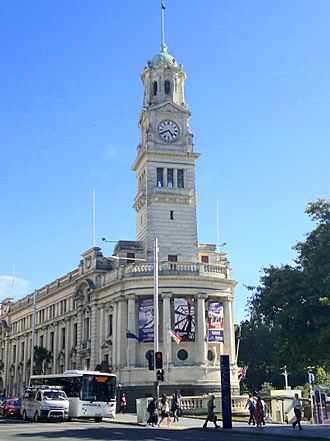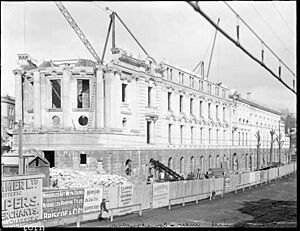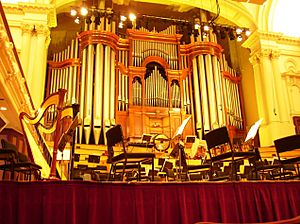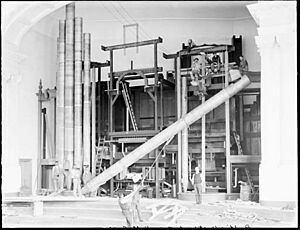Auckland Town Hall facts for kids
Quick facts for kids Auckland Town Hall |
|
|---|---|

Exterior of venue viewed from Queen Street
|
|
| General information | |
| Type | Civic |
| Architectural style | Italian Renaissance Revival |
| Location | Auckland CBD |
| Address | 305 Queen Street, Auckland, New Zealand |
| Construction started | 1909 |
| Inaugurated | 14 December 1911 |
| Renovated | 1994-97 |
| Cost | £126,000 |
| Renovation cost | $32.8 million |
| Owner | Auckland Council |
| Height | 45 m (148 ft) |
| Design and construction | |
| Architect | J Clark and Sons |
| Renovating team | |
| Structural engineer | Sinclair Knight Merz |
| Civil engineer | Downer Group |
| Other information | |
| Seating capacity | 1,529 (Great Hall) 431 (Concert Chamber) |
| Designated: | 27 July 1988 |
| Reference #: | 549 |
The Auckland Town Hall is a famous building on Queen Street in the heart of Auckland, New Zealand. It's an Edwardian style building, which means it was built during the time of King Edward VII (1901-1910). This building is used for important city meetings, like those for the Auckland Council, and also has a large Great Hall and a Concert Chamber for performances. The Town Hall is a very important historical place in Auckland. It is protected as a 'Category A' heritage site and is listed as a Category I Historic Place by Heritage New Zealand.
Contents
History of the Town Hall
Building the Hall
People in Auckland started planning for a town hall way back in 1872. In 1880, a spot was chosen at the corner of Greys Avenue and Queen Street. This area was made available by a special law in 1881. However, the space turned out to be too small. So, the city government bought more land next to it in 1883.
In 1908, a competition was held to find the best design for the building. The winners were architects J.J. & E.J. Clark from Melbourne, Australia.
Construction started on February 24, 1909. The mayor at the time, Arthur Myers, laid the first stone. The building officially opened on December 14, 1911. Lord Islington, who was the Governor of New Zealand, opened it. The Town Hall cost £126,000 to build. This would be about $21 million in 2017.
The building is made of Oamaru limestone from New Zealand and a dark stone called bluestone from Melbourne, Australia. It has a tall clocktower that is 40 metres high. The design looks like the Lambeth Town Hall in London, which was built around the same time. The Auckland Town Hall was the first main place for both city management and entertainment in Auckland's history. Its Great Hall can seat 1,673 people. It was designed to be like the Gewandhaus in Leipzig, Germany, and is known for having some of the best sound quality in the world.
Some people in Auckland had funny opinions about the building after it was finished. They said it looked like a piece of cheese or a flat iron!
Building Materials and Design
The outside of the Town Hall uses two kinds of stone. The ground floor is made of dark, rough volcanic basalt. This is different from the light-coloured stone used for the upper floors. The upper part of the building uses Oamaru limestone from the South Island of New Zealand. Even though the lower part looks like Auckland basalt, it actually came from Melbourne, Australia. This was probably because the architects knew they could get good quality stone from there. They also had strong saws to cut the difficult stone.
The inside of the building has many types of English ceramic tiles on the floors and walls. The Council Chamber, where meetings are held, is shaped like a half-circle. It has wooden walls and cool electric lights in an Art-Nouveau style. Stained glass windows are a beautiful feature in all the main rooms. The ceilings on all the main floors have fancy plasterwork. The Great Hall's ceiling is the most detailed.
The large four-sided clock in the tower was given by Arthur Myers. He was a Member of Parliament and a former mayor of Auckland. The pipe organ in the Great Hall was given by Sir Henry Brett. Arthur Myers was a big supporter of the Town Hall project. He worked on it before and during his time as mayor (1905-1909). Laying the foundation stone was one of his last actions as mayor.
Restoration Work
The inside of the Town Hall was fully repaired and updated between 1994 and 1997. This cost about NZ$33 million. One reason for the repair was that the building's stone walls were not strong enough for earthquake safety rules. An Australian engineering company called Sinclair Knight Merz found new ways to make the building stronger. They did this without changing its historical look too much.
In 2007, the outside of the building was also repaired. Some decorative parts on the outside had been taken off in the 1950s because of earthquake worries. Also, some of the Oamaru limestone was damaged when it was cleaned too roughly. After careful study, these parts were replaced with new limestone. This new stone came from the same quarry in North Otago that provided the original stone.
The sound quality inside the building was also fixed. Old, ugly changes that affected the sound were removed. They were replaced with better, less noticeable solutions. The paint colours inside were changed back to the original Edwardian-era colours. Broken porcelain and ceramic tiles in the main entrance were carefully fixed with new, exact copies. The original carpet was remade. A small piece of the old carpet was left in the Council Chamber as a reference. The stained glass windows were repaired or rebuilt if needed. The whole building was also given fire protection in a way that didn't change its look.
Town Hall Organ
The Town Hall Organ was built in 1911. It is the biggest musical instrument in New Zealand. It is even protected by New Zealand law as a 'Protected Object'. Henry Brett, a former mayor of Auckland, paid for it. An English organist named Edwin Lemare designed it. The company Norman and Beard in Norwich, England, built it.
The organ was changed a lot between 1969 and 1970. Many parts of the original organ were removed, and new ones were added. This changed its powerful, old-fashioned sound to a more popular Baroque sound of that time. The organ was taken apart in January 2008 to be restored and rebuilt.
The rebuilt organ now includes parts from the original 1911 organ, some recently found pieces, and new parts. It was built by Orgelbau Klais in Bonn, Germany. The organ came back to the Great Hall at the end of 2008. It was put back together as the largest and most powerful organ in the country once again.
Auckland City promised NZ$3 million for the restoration project. Another $500,000 was raised from private donations. The restored organ was officially shown to the public on March 21, 2010. A special symphony was played for the occasion.
Auckland Philharmonia Orchestra
In early February 2016, the main staff of the Auckland Philharmonia, which is New Zealand's largest city orchestra, moved into the old mayoral office. This made the Auckland Town Hall their new home. The orchestra often performs there.
Images for kids
-
Town Hall entrance from Queen Street
See also
 In Spanish: Ayuntamiento de Auckland para niños
In Spanish: Ayuntamiento de Auckland para niños







